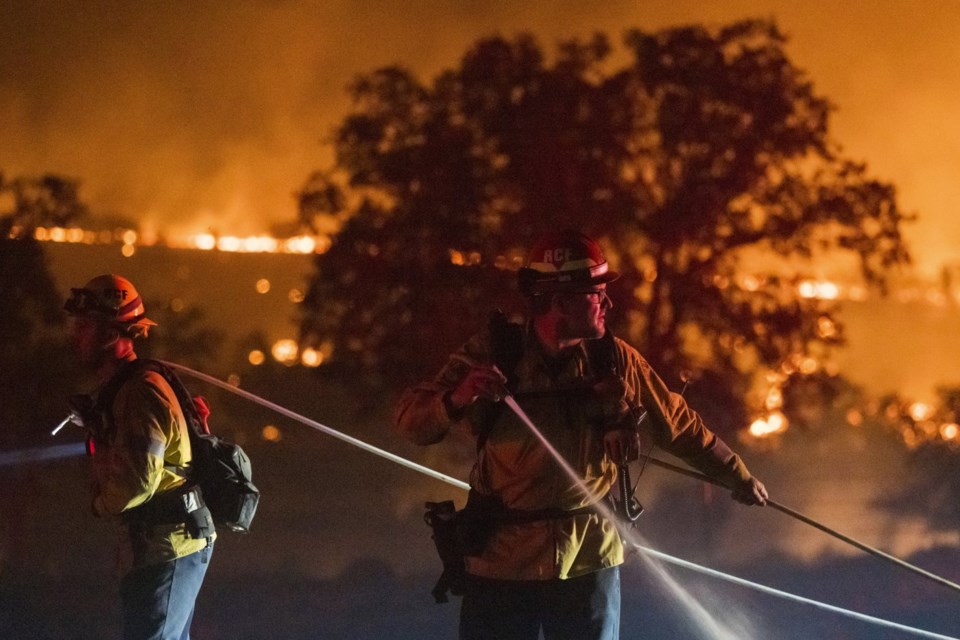CHICO, Calif. (AP) — Firefighters battling California’s largest wildfire of the year are preparing for treacherous conditions entering the weekend, when expected thunderstorms may unleash fire-starting lightning and erratic winds that could erode progress made over the past week. Dry, hot conditions posed similar threats across the .
Weather, fuels and terrain will pose challenges for the nearly 6,400 firefighters battling the Park Fire, which has spread over 624 square miles (1,616 square kilometers) since in a park in the Sierra Nevada foothills east of the Sacramento Valley city of Chico. It is now California's fourth-largest wildfire on record.
Suppression crews working on more than 200 miles (322 kilometers) of active fire front gained 24% containment by early Friday, Cal Fire said. Temperatures were expected to range up to 103 degrees Fahrenheit (39.4 degrees Celsius).
The fire originated at low elevations where it quickly burned through thick grass and oaks, destroying at least 542 structures and damaging 50 since erupting July 24. As it has climbed higher, the vegetation has changed to a greater concentration of trees and brush, Cal Fire said.
The fire's push northward has brought it toward the rugged lava rock landscape surrounding Lassen Volcanic National Park, which has been closed because of the threat.
“Lava rocks make for hard and slow work for hand crews,” Cal Fire said in situation report. “Crews are being flown into access areas that have been hard to reach because of long drive times and steep, rugged terrain.”
After days of benign weather, increasing winds and a surge of monsoonal moisture were expected to increase fire activity and bring a chance of thunderstorms Friday night into Saturday, said Ryan Walbrun, incident meteorologist with the National Weather Service.
“The concern with thunderstorms is any gusty outflow winds that would push the fire itself or create some new fire ignitions within the vicinity of the Park Fire,” Walbrun said.
The collapse of thunderstorm clouds can blow wind in any and all directions, said Jonathan Pangburn, a fire behavior analyst with Cal Fire.
“Even if there's not lightning per se, it is very much a safety-watch-out environment for our firefighters out there,” Pangburn said.
Walbrun said there was little prospect of beneficial rains from the storms and the forecast for next week calls for continued warming and drying.
“As we look forward in time, we’re really just entering the peak of fire season in California,” he said.
The Park Fire is among almost 100 large fires burning across the western U.S. Evacuation orders were in effect for 28 of the fires, according to the National Interagency Fire Center.
Three wildfires on Friday near heavily populated areas north and south of Denver, with some 30 structures damaged or destroyed, thousands of people under evacuation orders and human remains found in a destroyed house earlier this week.
The Jefferson County Sheriff’s Office disclosed Friday that a blaze threatening hundreds of homes near the Colorado city of Littleton was being . Karlyn Tilley, a spokesperson for Jefferson County Sheriff’s Office, said the investigation is ongoing and they are using a dog specially trained to sniff out sources and causes of fires. Tilley said just because they suspect the fire was human-caused doesn’t mean it was intentional. Firefighters were making good progress on the fire despite the steep, rocky terrain and blistering heat, and no houses had been burned, officials said.
The cause and origin of a fatal blaze west of the town of Lyons was being probed by the federal Bureau of Alcohol, Tobacco and Firearms, with specially trained fire investigators from the agency helping local authorities, agency spokesperson Crystal McCoy said. The area blackened by that fire remained relatively unchanged after it burned five houses.
The largest of the Colorado fires, west of Loveland, grew to 13 square miles (33 square kilometers) after previously burning about two dozen homes and other structures. Its cause is under investigation.
Cooler weather was expected across the region Friday with some scattered showers, before hot dry conditions return for the weekend.
A new fire sparked Friday afternoon in Oregon’s high desert, near the popular vacation destination of Bend, prompting evacuation notices, cutting power to thousands and slowing traffic along a highway. Fire officials said the blaze spread quickly amid 100-degree (37.7-degree C) heat and a warning from the National Weather Service about the potential for extreme fire behavior. Multiple agencies stopped the fire's forward progression as of Friday evening, officials said.
Scientists say extreme wildfires are becoming more common and destructive in the U.S. West and other parts of the world as the planet and droughts become more severe.
___
Associated Press reporters contributing to this report include Jesse Bedayn, Matthew Brown and Lisa Baumann.
Ty Oneil And John Antczak, The Associated Press




